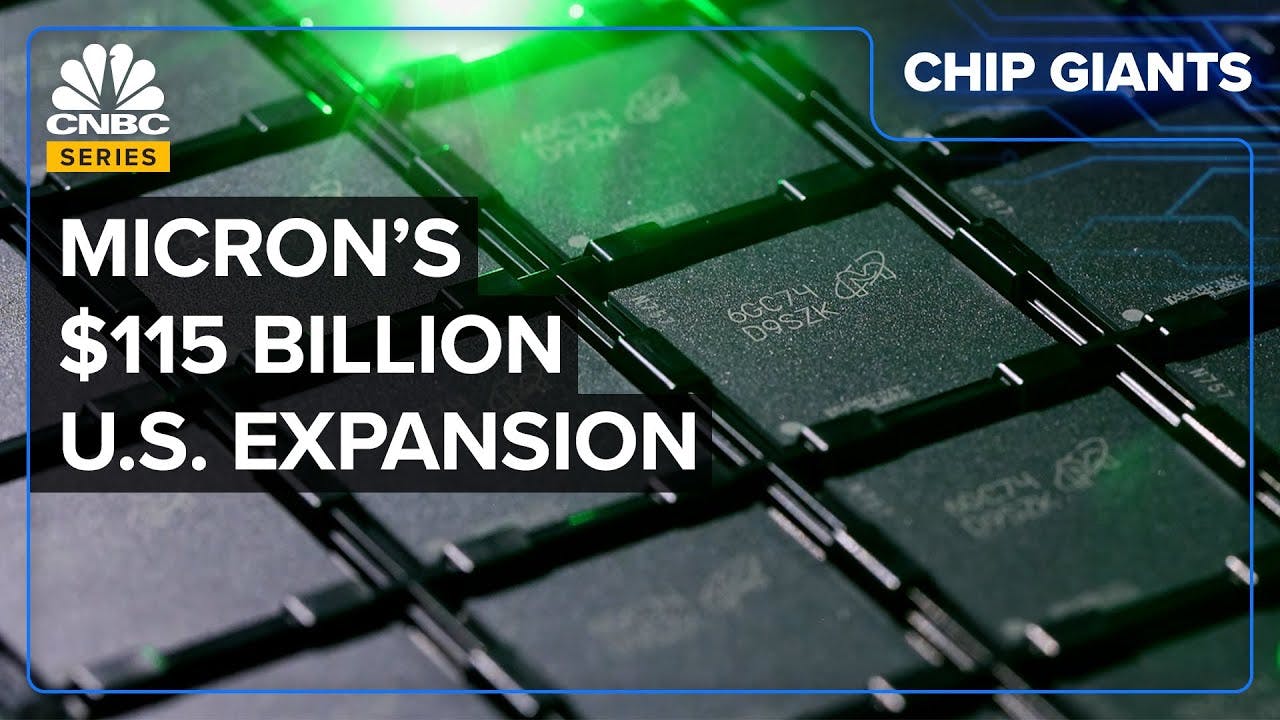How Micron’s Building Biggest U.S. Chip Fab, Despite China Ban
30 Oct 2023 (2 years ago)

Introduction (0s)
- Memory chips are essential for data storage and accessing that data in technological devices, including generative AI.
- Micron is the only major memory maker based in the U.S., focusing primarily on DRAM chips.
- Despite memory being less expensive than other semiconductors, memory chips require more space to be produced.
- Micron has undergone significant growth, with a new chip fabrication plant being built in Boise, Idaho, and plans for four more in New York, marking the biggest U.S. chip project in history.
- Despite the opportunities, Micron's position as the only U.S memory maker carries risks, including being affected by China's ban on U.S. chips and the challenge of maintaining growth amid a market oversupply and geopolitical turmoil.
Rise of memory and Micron (2m12s)
- Founded in 1978 and going public in 1984, Micron has contributed significantly to the memory industry, with notable products like the 64k DRAM chip used in early personal computers.
- The total global semiconductor industry revenue has seen memory usage rise from 10% at the start of the century to 25-30% today.
- Despite fierce competition in the past, Micron continued to sustain its market share by making strategic acquisitions.
- Micron's profits in 2022 took a hit due to weakened demand for PCs and smartphones, leading to staff reductions, but the company remains optimistic on future demand.
- Micron produces memory for phones from Apple, Motorola, Asus, and more.
- The company's most advanced product, High Bandwidth Memory (HBM), is set for volume production next year and brings significant advantages in memory capacity and performance, which are critical for AI applications.
Banned by China (7m18s)
- China's ban on certain Micron sales presents a large challenge for the company as roughly 25% of its business revenue comes from China, with around half of that now being at risk.
- The ban is part of the broader geopolitical chip war between the U.S. and China, pushing Micron and other companies to diversify their bases.
- As a response to the ban, Micron is constructing a $2.75 billion assembly and test facility in India.
- China is currently sourcing memory from Samsung, SK Hynix, and smaller local memory manufacturers due to Micron's ban.
- There's speculation that China might reconsider the Micron ban when demand increases and other suppliers can't fulfill required volumes.
- Despite the geopolitical struggle, navigating disputes related to intellectual property, such as a past case with Chinese chip company Fujian Jinhua, remains critical for Micron's success.
What it takes to make memory (10m40s)
- Micron celebrated its 45th anniversary by commencing the construction of a new fabrication plant or 'fab' in Boise.
- Both Boise and New York plants will produce 300 millimeter wafers with memory technology, the most advanced size in volume production.
- Micron currently operates its headquarters and R&D facility in Boise, a memory fab in Manassas, Virginia, and has offices in five other states. Its high-tech nodes are in Japan and Taiwan.
- By 2026, Micron expects to begin advanced production at the Boise fab and at a fully built-out facility in New York. The latter is projected to produce over 100,000 wafers per month.
- The creation of each silicon wafer involves over 1000 steps and at least 90 days of processing.
- Memory chip production must achieve an economy of scale to meet market demands as they are cost-sensitive compared to high-cost logic chips. This necessity makes Micron's fabs larger than that for logic chip production.
- The large fabs accommodate hefty equipment, like a $250 million extreme ultraviolet photolithography machine needed for printing minuscule features on the chips.
- These machines are solely produced by ASML, a Dutch company, and they require significant power. Each of Micron's new fabs will use energy equivalent to that used by 25,000 homes.
- Access to affordable, reliable and renewable energy, which the U.S provides, is critical for the fabs' operation. Energy costs in the U.S are about 25% of equivalent energy costs in Asia.
- The production process requires massive amounts of water. The fabs being planned in New York will each consume water equivalent to 25 Olympic-sized swimming pools daily, 75% of which will be reused and recycled on-site.